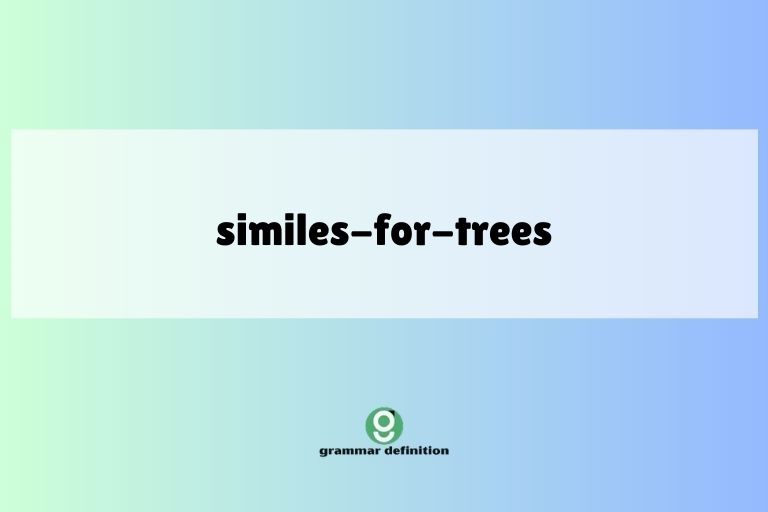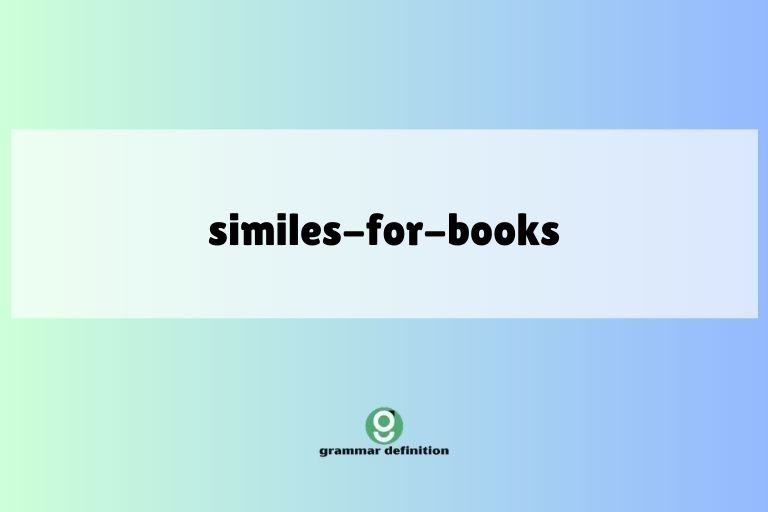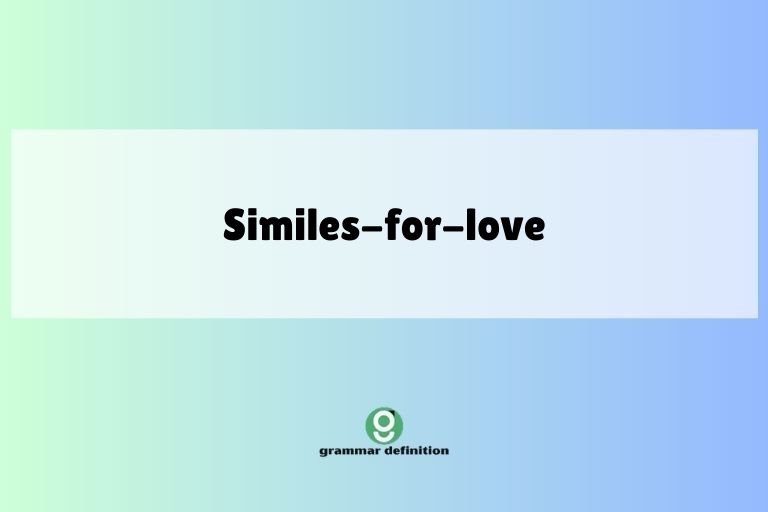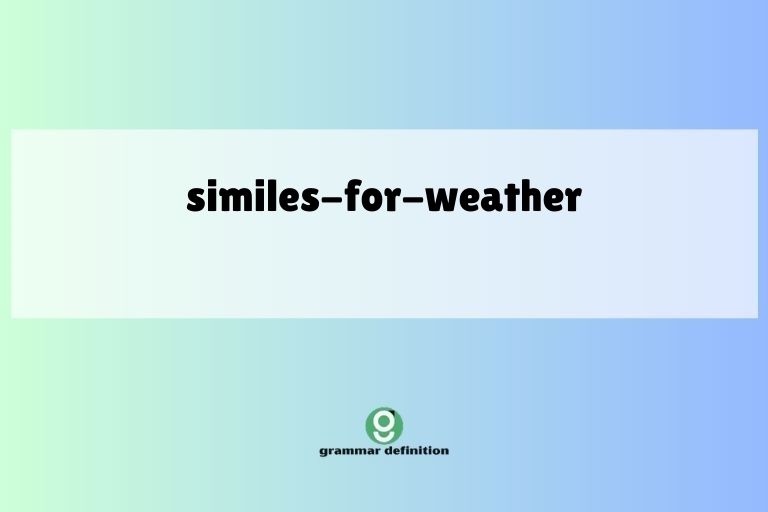Similes for Change: A Guide to Expressing Transformation
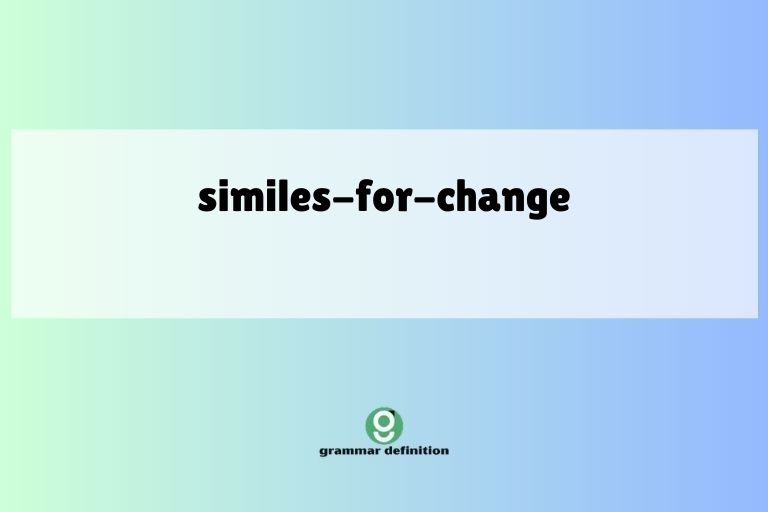
Similes are powerful literary devices that enhance our writing and speech by drawing comparisons between seemingly unlike things. When used to describe change, similes can vividly illustrate the nature, speed, and impact of transformation.
Understanding how to effectively use similes for change allows us to communicate complex ideas in a more engaging and memorable way. This article will explore the definition, structure, types, and usage of similes for change, providing numerous examples and exercises to help you master this essential skill.
This guide will benefit students, writers, and anyone looking to improve their descriptive language and communication skills.
Table of Contents
- Introduction
- Definition of Similes for Change
- Structural Breakdown
- Types of Similes for Change
- Examples of Similes for Change
- Usage Rules
- Common Mistakes
- Practice Exercises
- Advanced Topics
- FAQ
- Conclusion
Definition of Similes for Change
A simile is a figure of speech that compares two unlike things using the words “like” or “as.” Its primary function is to create a vivid image or deepen understanding by highlighting a shared quality between the two things being compared. When used to describe change, similes illustrate how something is transforming from one state to another.
This can involve changes in appearance, behavior, attitude, or any other measurable aspect. The effectiveness of a simile lies in its ability to make abstract concepts more concrete and relatable.
For example, saying “His mood changed like the weather” uses a simile to compare the unpredictability of someone’s mood to the fluctuating nature of the weather. This makes the suddenness and variability of the mood more understandable.
Similes are often used in literature, poetry, and everyday conversation to add color and emphasis to descriptions of change.
Structural Breakdown
The basic structure of a simile consists of three key elements: the subject, the connecting word (“like” or “as”), and the object of comparison. Understanding this structure is crucial for creating effective and grammatically correct similes.
- Subject: The thing that is undergoing change. This could be a person, object, situation, or concept.
- Connecting Word: “Like” or “as” are the most common words used to connect the subject and the object of comparison. “So” can also be used, though less frequently.
- Object of Comparison: The thing to which the subject is being compared. This should be something familiar or easily understood, so the comparison is clear.
The order of these elements can sometimes be varied for stylistic effect, but the core components must remain present. For instance, instead of “She changed like a chameleon,” you could say, “Like a chameleon, she changed,” though the first construction is more common.
The key is to ensure that the comparison remains clear and logical.
Types of Similes for Change
Similes for change can be categorized based on the type of change they describe or the specific effect they aim to achieve. Here are a few common types:
Similes Describing Speed of Change
These similes focus on how quickly or slowly a change occurs. They often use imagery related to speed or slowness to emphasize the rate of transformation.
Similes Describing Nature of Change
These similes highlight the specific qualities or characteristics of the change, such as its intensity, direction, or impact. They help to paint a more detailed picture of the transformation.
Similes Describing Impact of Change
These similes emphasize the effect or consequence of the change, focusing on how it alters the subject or its environment. They are useful for conveying the significance of the transformation.
Similes Describing Emotional Change
These similes focus on changes in feeling, mood, or emotional state. They use emotional imagery to make the change more relatable and impactful.
Examples of Similes for Change
Here are several organized tables with examples of similes for change, categorized by the aspect of change they describe.
Table 1: Similes Describing Speed of Change
The following table presents examples of similes that describe the speed at which a change occurs, using various comparisons to illustrate rapid or gradual transformations.
| Simile | Explanation |
|---|---|
| His anger flared up like a match. | The anger appeared suddenly and intensely. |
| Her confidence grew like a weed. | The confidence increased rapidly and uncontrollably. |
| The news spread like wildfire. | The news disseminated very quickly to many people. |
| The ice melted as slowly as molasses in January. | The melting was exceptionally slow. |
| His hair turned gray as fast as the seasons change. | The graying of the hair was noticeable and relatively quick. |
| The project progressed like a snail. | The project advanced very slowly. |
| Her tears flowed like a river. | The tears came quickly and abundantly. |
| His enthusiasm waned as slowly as a sunset. | The enthusiasm faded gradually over time. |
| The rumor spread like a virus. | The rumor spread quickly and widely. |
| The paint dried as quickly as a desert after rain. | The paint dried extremely fast. |
| The plant grew like Jack’s beanstalk. | The plant grew incredibly quickly and tall. |
| The economy recovered as slowly as a patient healing from a severe illness. | The recovery was gradual and painstaking. |
| The leaves fell like autumn rain. | The leaves fell quickly and in great numbers. |
| His heart sank like a stone. | His heart sank rapidly and heavily. |
| The tide receded as slowly as time itself. | The tide receded almost imperceptibly slowly. |
| Her smile faded like a dream. | Her smile disappeared quickly and completely. |
| The situation deteriorated like a house of cards. | The situation deteriorated rapidly and unstably. |
| The conversation progressed like a chess game. | The conversation progressed strategically and thoughtfully, but slowly. |
| The clouds gathered as quickly as a closing curtain. | The clouds gathered very rapidly. |
| The fire spread like an angry beast. | The fire spread rapidly and destructively. |
| The news traveled as fast as a speeding bullet. | The news spread extremely quickly. |
| The snow melted like butter on a hot stove. | The snow melted very quickly. |
| His hope dwindled as slowly as the last embers of a fire. | His hope dwindled almost imperceptibly slowly. |
Table 2: Similes Describing Nature of Change
This table provides examples of similes that illustrate the nature or characteristics of a change, focusing on its qualities and attributes.
| Simile | Explanation |
|---|---|
| Her voice changed, becoming like velvet. | The voice became smooth and rich. |
| The relationship transformed like a caterpillar into a butterfly. | The relationship underwent a beautiful and complete transformation. |
| His attitude shifted like a compass needle. | His attitude changed direction abruptly. |
| The argument escalated like a runaway train. | The argument intensified rapidly and uncontrollably. |
| The company restructured itself like a puzzle being reassembled. | The company reorganized in a deliberate and complex manner. |
| The city evolved like a living organism. | The city developed naturally and continuously. |
| His plan unraveled like a poorly knitted sweater. | His plan fell apart easily and completely. |
| The project morphed like clay in the hands of a sculptor. | The project changed shape and form under careful guidance. |
| Her personality blossomed like a flower in spring. | Her personality became more vibrant and beautiful. |
| The problem festered like a wound left untreated. | The problem worsened due to neglect. |
| The political landscape shifted like sand dunes in the wind. | The political landscape changed unpredictably and dramatically. |
| The rules bent like reeds in the wind. | The rules were flexible and easily adapted. |
| His resolve hardened like steel. | His determination became strong and unyielding. |
| The situation clarified like a fog lifting. | The situation became clear and understandable. |
| Her spirit soared like an eagle. | Her spirit rose high and freely. |
| The tension mounted like a coiled spring. | The tension increased steadily and intensely. |
| His dreams shattered like glass. | His dreams were broken easily and irreparably. |
| The truth emerged like a phoenix from the ashes. | The truth arose powerfully from destruction. |
| The market fluctuated like a yo-yo. | The market went up and down erratically. |
| The policy was watered down like weak tea. | The policy was made less effective and impactful. |
| The friendship soured like milk left out in the sun. | The friendship became unpleasant and spoiled. |
| His principles wavered like a candle in the wind. | His principles became unstable and uncertain. |
| The argument escalated like a snowball rolling downhill. | The argument grew larger and more uncontrollable. |
Table 3: Similes Describing Impact of Change
The following table showcases similes that focus on the impact or consequence of a change, highlighting its effects on the subject or its surroundings.
| Simile | Explanation |
|---|---|
| The news hit him like a ton of bricks. | The news had a devastating and overwhelming effect. |
| Her departure left a void like a missing limb. | Her departure created a significant and painful absence. |
| The decision changed everything like a domino effect. | The decision triggered a series of consequences. |
| The betrayal stung like a bee. | The betrayal caused a sharp and painful feeling. |
| The victory felt like climbing Mount Everest. | The victory felt like a monumental achievement. |
| The failure tasted like bitter medicine. | The failure was unpleasant and difficult to accept. |
| The success shone like a beacon. | The success was bright and inspiring. |
| The loss echoed like a hollow drum. | The loss created a deep and resonant emptiness. |
| The experience transformed her like a crucible. | The experience refined and strengthened her. |
| The criticism landed like a slap in the face. | The criticism was harsh and insulting. |
| The opportunity knocked like a gentle breeze. | The opportunity presented itself subtly and invitingly. |
| The memory lingered like a ghost. | The memory remained haunting and persistent. |
| The impact resonated like ripples in a pond. | The impact spread outwards and affected many things. |
| The change felt like shedding an old skin. | The change felt like a freeing and transformative experience. |
| The relief washed over him like a tidal wave. | The relief was overwhelming and complete. |
| The challenge loomed like a mountain. | The challenge appeared daunting and insurmountable. |
| The solution emerged like a light at the end of the tunnel. | The solution provided hope and clarity. |
| The reform swept through the nation like a hurricane. | The reform caused widespread and dramatic changes. |
| The mistake haunted him like a specter. | The mistake continued to trouble him persistently. |
| The invention revolutionized the world like the printing press. | The invention brought about a major and lasting transformation. |
| The impact of the policy was felt like a ripple effect. | The policy’s impact spread gradually and widely. |
| The revelation shocked him like a bolt from the blue. | The revelation was sudden and unexpected. |
Table 4: Similes Describing Emotional Change
This table focuses on similes that depict changes in emotions, moods, or feelings, using evocative comparisons to illustrate these shifts.
| Simile | Explanation |
|---|---|
| Her happiness bloomed like a spring flower. | Her happiness grew beautifully and vibrantly. |
| His sadness enveloped him like a dark cloud. | His sadness surrounded him completely and oppressively. |
| Her anger flared like a sudden storm. | Her anger erupted quickly and intensely. |
| His fear gripped him like a vise. | His fear held him tightly and painfully. |
| Her hope flickered like a candle in the wind. | Her hope was fragile and unstable. |
| His love grew like a sturdy oak tree. | His love became strong and enduring. |
| Her joy bubbled like a sparkling fountain. | Her joy was effervescent and overflowing. |
| His grief weighed him down like heavy chains. | His grief was burdensome and restrictive. |
| Her excitement soared like a kite in the sky. | Her excitement reached great heights and was unrestrained. |
| His disappointment stung like a slap. | His disappointment was sharp and hurtful. |
| Her relief washed over her like a warm bath. | Her relief was soothing and comforting. |
| His anxiety gnawed at him like a persistent hunger. | His anxiety troubled him constantly. |
| Her confidence blossomed like a rose in full bloom. | Her confidence grew beautifully and completely. |
| His despair spread like a stain. | His despair permeated everything. |
| Her optimism shone like the sun. | Her optimism was bright and radiant. |
| His loneliness enveloped him like a shroud. | His loneliness surrounded him completely and depressingly. |
| Her gratitude flowed like a river. | Her gratitude was abundant and continuous. |
| His frustration mounted like a rising tide. | His frustration increased steadily and powerfully. |
| Her peace settled over her like a gentle snowfall. | Her peace was calm and serene. |
| His worry gnawed at him like a rat. | His worry troubled him persistently and destructively. |
Usage Rules
Using similes effectively requires adherence to certain rules and considerations. Here are some key guidelines:
- Clarity: The comparison should be clear and easily understood. Avoid obscure or confusing references.
- Relevance: The object of comparison should share a relevant quality with the subject. The similarity should be meaningful.
- Originality: While common similes can be effective, strive for originality to make your writing more engaging and memorable.
- Context: Ensure the simile is appropriate for the tone and context of your writing. Avoid using overly dramatic or inappropriate comparisons.
- Grammar: Use “like” or “as” correctly. “Like” is a preposition, while “as” can be a conjunction or preposition.
Remember that the goal of a simile is to enhance understanding and create a vivid image. If the comparison is unclear, irrelevant, or inappropriate, it will detract from your writing rather than enhance it.
Common Mistakes
Several common mistakes can undermine the effectiveness of similes. Being aware of these pitfalls can help you avoid them.
| Incorrect | Correct | Explanation |
|---|---|---|
| He changed like good. | He changed like a good person. | “Good” is an adjective; it needs a noun to be compared. |
| She is as tall like a tree. | She is as tall as a tree. | Using both “as” and “like” is redundant. |
| The change was like something. | The change was like a sudden shock. | The comparison is too vague and lacks a specific object. |
| He changed as the changing of the weather. | He changed like the weather. | The phrasing is unnecessarily complex. |
| The situation is like a confusing thing. | The situation is like a maze. | “Confusing thing” is too general; a more specific comparison is needed. |
| The reform was like success. | The reform was like a resounding success. | Adding an adjective enhances the comparison. |
| The team worked like winning. | The team worked like a well-oiled machine. | “Winning” is a verb form; it needs a noun for comparison. |
| The plan was like a doing something. | The plan was like a blueprint. | “Doing something” is too vague; a specific comparison is needed. |
Avoiding these common errors will help you create more effective and impactful similes.
Practice Exercises
Test your understanding of similes for change with these practice exercises. Each exercise contains 10 questions with an answer key provided.
Exercise 1: Identifying Similes for Change
Identify the simile in each sentence and explain what kind of change it describes (speed, nature, or impact).
| Question | Answer |
|---|---|
| 1. His anger erupted like a volcano. | Simile: like a volcano. Type: Speed (suddenness of anger). |
| 2. Her confidence grew like a blooming flower. | Simile: like a blooming flower. Type: Nature (beauty and vibrancy). |
| 3. The news hit her like a tidal wave. | Simile: like a tidal wave. Type: Impact (overwhelming effect). |
| 4. The economy recovered as slowly as a snail crawling. | Simile: as slowly as a snail crawling. Type: Speed (slowness of recovery). |
| 5. His mood shifted like the wind. | Simile: like the wind. Type: Nature (unpredictability). |
| 6. The pain lingered like a shadow. | Simile: like a shadow. Type: Impact (persistence). |
| 7. The project evolved like a complex organism. | Simile: like a complex organism. Type: Nature (complexity and development). |
| 8. Her dreams shattered like glass. | Simile: like glass. Type: Impact (fragility and destruction). |
| 9. The tension mounted like a coiled spring. | Simile: like a coiled spring. Type: Nature (increasing intensity). |
| 10. The reform swept through the nation like a storm. | Simile: like a storm. Type: Impact (widespread and dramatic changes). |
Exercise 2: Completing Similes for Change
Complete each sentence with an appropriate simile that describes the change indicated.
| Question | Answer |
|---|---|
| 1. His fear grew __________. | like a dark shadow. |
| 2. The situation deteriorated __________. | like a house of cards. |
| 3. Her love blossomed __________. | like a rose in spring. |
| 4. The news spread __________. | like wildfire. |
| 5. His heart sank __________. | like a stone. |
| 6. The pain eased __________. | like a gentle breeze. |
| 7. Her smile faded __________. | like a dream. |
| 8. The project progressed __________. | like a slow train. |
| 9. The leaves fell __________. | like tears from the sky. |
| 10. His determination hardened __________. | like steel. |
Exercise 3: Rewriting Sentences with Similes for Change
Rewrite each sentence using a simile to describe the change more vividly.
| Question | Answer |
|---|---|
| 1. His anger appeared suddenly. | His anger flared up like a match. |
| 2. Her confidence increased rapidly. | Her confidence grew like a weed. |
| 3. The news traveled very quickly. | The news spread like wildfire. |
| 4. The ice melted very slowly. | The ice melted as slowly as molasses in January. |
| 5. His hair turned gray quickly. | His hair turned gray as fast as the seasons change. |
| 6. The project advanced very slowly. | The project progressed like a snail. |
| 7. Her tears flowed abundantly. | Her tears flowed like a river. |
| 8. His enthusiasm faded gradually. | His enthusiasm waned as slowly as a sunset. |
| 9. The rumor spread quickly and widely. | The rumor spread like a virus. |
| 10. The paint dried extremely fast. | The paint dried as quickly as a desert after rain. |
Advanced Topics
For advanced learners, exploring the nuances of similes can further enhance their writing. Consider these advanced topics:
- Extended Similes: Developing a simile over several sentences or paragraphs to create a more detailed and impactful comparison.
- Subverted Similes: Intentionally creating a simile that is unexpected or ironic to achieve a specific effect.
- Metaphor vs. Simile: Understanding the subtle differences between metaphors and similes and knowing when to use each effectively.
- Cultural Context: Recognizing that similes can be culturally specific and adapting them for different audiences.
By mastering these advanced concepts, you can use similes to create truly sophisticated and compelling writing.
FAQ
Here are some frequently asked questions about similes for change:
- What is the difference between a simile and a metaphor?
A simile explicitly compares two things using “like” or “as,” while a metaphor implies a comparison by stating that one thing *is* another. Similes are generally more direct and less ambiguous than metaphors.
- Can a simile be too obvious or cliché?
Yes, overused similes can make your writing seem unoriginal and predictable. Strive for fresh and creative comparisons to make your writing more engaging.
- How can I create more original similes?
Pay attention to the specific qualities you want to emphasize and brainstorm a wide range of possible comparisons. Look for unexpected connections and consider using imagery from different fields or experiences.
- Is it better to use “like” or “as” in a simile?
Both “like” and “as” are acceptable, but “as” can sometimes be more formal or literary. The best choice depends on the specific context and the sound and rhythm of the sentence.
- Can a simile be used to describe something abstract?
Yes, similes are often used to make abstract concepts more concrete and understandable by comparing them to something tangible or familiar.
- How do I know if my simile is effective?
An effective simile should enhance the reader’s understanding and create a vivid image. If the comparison is confusing or irrelevant, it is not effective.
- What are some common sources of inspiration for creating similes?
Nature, everyday objects, emotions, and personal experiences are all excellent sources of inspiration for creating similes. Think about the qualities you want to highlight and look for things that share those qualities.
- Can a simile be used in formal writing?
Yes, similes can be used in formal writing, but they should be used sparingly and with careful consideration. Avoid overly informal or colloquial comparisons.
Conclusion
Mastering the use of similes for change can significantly enhance your ability to communicate effectively and vividly. By understanding the structure, types, and usage rules of similes, you can create compelling descriptions that bring your writing to life.
Remember to strive for clarity, relevance, and originality in your comparisons, and avoid common mistakes that can undermine their effectiveness. Practice using similes in your writing and speech, and pay attention to how other writers use them to create powerful imagery and convey complex ideas.
With practice and attention, you can master the art of using similes to express transformation.

